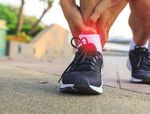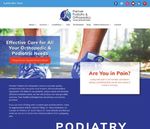April 2021 - Premier Podiatry and Orthopedics
←
→
Page content transcription
If your browser does not render page correctly, please read the page content below
News and Updates
April 2021
April Is
National Foot
Health Awareness
Month
According to the American Podiatric Medical Association, a person typically takes 8,000 to 10,000 steps per
day. Over an average life span, that’s roughly four trips around the globe — quite a hike.
A foot’s workload and complexity — 26 bones, 33 joints, and a network of over 100 ligaments, muscles, and
tendons — sometimes lead to trouble without proper attention. Twenty percent of Americans experience at
least one foot problem per year.
National Foot Health Awareness Month is a reminder of the importance of keeping your feet in tip-top shape
year-round:
• Don’t ignore lingering foot or ankle pain. It’s a signal that something is wrong; it’s never “normal.”
Promptly schedule a podiatric exam.
• Inspect your feet daily — tops, bottoms, between the toes, and heels. This is especially important for
those with diabetes to stay ahead of infection and nonhealing wounds.
• Footwear should fit well, have good arch support, low heels, shock-absorbent soles, and be activity-
specific. For some issues, orthotics may prove beneficial.
• Replace athletic shoes every six months or 500 miles. Rotate pairs to give them a chance to dry out, which
lowers the risk of infection.
• Exercise regularly and eat a healthy diet to achieve or maintain a healthy weight, which reduces the
burden on feet and ankles.
• When applying sunscreen, don’t forget your feet!
• Wash your feet each day, and thoroughly dry them (between the toes, too).
• Visit our office for an annual foot exam (critically important for diabetics). We can diagnose and treat
abnormalities of the feet and ankles; prevent or correct deformities; treat infections; relieve pain; analyze
gait; offer guidance on proper footwear; monitor feet when systemic conditions are in play (e.g., diabetes);
and perform surgery when other options are exhausted.
Premier Podiatry & Orthopedics • (916) 961-3434 • PPOSac.comDon’t Give Chronic
Ankle Instability an
Open Invitation
Most people at one time or another have sprained an ankle. Falls, landing awkwardly on your foot after jumping
or pivoting, and walking or running on uneven surfaces can all do the trick.
When you sprain an ankle, ligaments — tough bands of tissue that stabilize joints — get stretched beyond their
normal range of motion. In some cases, they tear, partially or completely. What you do, or don’t do, following an
ankle sprain can have long-term consequences.
Most sprains will result in some degree of discomfort and swelling. The RICE method (Rest, Ice, Compression,
and Elevation) should be your first course of action. This may be all that’s needed for a mild sprain. You should
experience significant improvement within a few days.
Moderate to serious sprains include increased pain and swelling, and possibly bruising or difficulty putting weight
on the ankle. In addition to RICE, call our office right away. We will examine the ankle to gauge the extent of the
damage and to rule out additional causes of your discomfort (e.g., a fracture).
Without treatment, you run the risk of developing chronic ankle instability. Ligaments that don’t heal properly
can’t provide needed ankle-joint stability. The ankle may “give way” while walking or engaging in other activities,
or even while just standing. Ankle instability leads to more sprains; each sprain worsens instability. A vicious cycle.
There might be ongoing tenderness and swelling as well.
Chronic ankle instability decreases quality of life and could possibly lead to surgery. Moderate and severe ankle
sprains call for prompt podiatric action. Even seemingly mild ones should be checked out if healing is lagging.
Mark Your Calendars
April 2 Reconciliation Day: Patch up those shaky relationships before it’s too
late.
April 11 Eight-Track Tape Day: Nothing like a favorite song split into two
segments.
April 12 Grilled Cheese Sandwich Day: Americans consume 2.2 billion/year. Is
that all?
April 14 National Dolphin Day: Dolphins are a type of whale, but not all whales
are dolphins.
April 19 National Garlic Day: Dracula suffered from alliumphobia.
April 22 Jelly Bean Day: Jelly Belly was the first brand in space (1983 Challenger
mission).
April 27 Babe Ruth Day: The first player to earn $50,000+ per year ($793K in
today’s dollars).
2Not All
Sugars Are Slow-Cooker
the Same Vegetable
Natural sugars are found in fresh fruits and vegeta-
bles (fructose), or dairy products such as milk and
cheese (lactose), among others. They typically come Minestrone
Soup
integrated with important vitamins, minerals, fiber,
and protein.
“Added sugars” are sugars added to foods or drinks
during processing or preparation. Generally, these
sugars (a.k.a. “refined sugars”) have been extracted Servings: 8; prep time: 30 mins.; cooking time: 6 to 8 hrs.
from sugar cane or sugar beets, and stripped of the
plants’ nutritional benefits. Added sugars are more This crock-pot version of minestrone is heavy on the
highly concentrated than natural sugars. vegetables and light on the pasta, keeping carbs in
check while providing plenty of flavor.
The body metabolizes natural and added sugars
quite differently. Added sugars are broken down Ingredients
rapidly in the digestive tract, causing blood-sugar • 4 large carrots, peeled and chopped
and insulin levels to skyrocket. With rapid diges- • 3 stalks celery, chopped
tion, there’s room for more food, more quickly. • 1 small red onion, chopped
Overconsumption of processed foods is a recipe for • 3 cloves garlic, minced
weight gain and its associated health consequences. • 2 cups fresh green beans, trimmed and cut into
2-inch pieces
Conversely, proteins (and fats) in dairy products and • 2 cans (15-ounce) no-sodium-added red kidney
the fiber in fresh fruits and veggies cause the diges- beans, rinsed
tive tract to work harder (fiber is never truly digested), • 2 cans (15-ounce) no-sodium-added diced
slowing digestion and stabilizing blood-sugar levels. tomatoes, undrained
Fiber also absorbs water and expands, making a per- • 6 cups no-sodium-added vegetable broth
son feel fuller. • 2 tablespoons Italian seasoning
• 1 teaspoon crushed red pepper
Honey and maple syrup are considered added sugars, • 3/4 teaspoon salt, divided
despite their natural form. Their effects mirror those of • 1/2 teaspoon ground pepper
added sugars. They offer sweetness but little more. • 1 large zucchini, chopped
• 4 ounces whole-wheat pasta elbows or other
As of 2020, all food labels must distinguish between small pasta (about 1 cup)
sugars (natural) and added sugars. It pays to check • 1/2 cup freshly grated Parmesan cheese
them. Added-sugar amounts often fly under the
radar, examples being salad dressings, spaghetti Directions
sauces, canned soups, frozen pizzas, ketchup, etc. Step 1. Combine carrots, celery, onion, garlic, green
beans, kidney beans, tomatoes, broth, Italian sea-
The 2015–2020 Dietary Guidelines for Americans soning, crushed red pepper, 1/4 teaspoon salt, and
recommends 48 grams or less of added sugars pepper in a 6- to 8-qt. slow cooker. Cover and cook
in a 2,000-calorie/day diet. The American Heart on low for 6 to 8 hours.
Association is less forgiving: 24 grams per day for
women; 36 for men. (Note: These guidelines are for Step 2. Stir in zucchini, pasta, and the remaining 1/2
people who don’t have diabetes. Diabetics should teaspoon salt. Cover and cook on low until the pasta
is tender, 15 to 20 minutes more. Serve immediately,
follow doctor recommendations.)
topping each serving with about 1½ tablespoons
Parmesan.
Equipment
6- to 8-qt. slow cooker
Recipe courtesy of the EatingWell website,
www.eatingwell.com.
36620 Coyle Avenue, Suite 202
Carmichael, CA 95608
576 N Sunrise Avenue, Suite 230
Roseville, CA 95661
(916) 961-3434
Visit our website!
PPOSac.com
No part of this newsletter may be used or reproduced in any manner whatsoever without written permission of the author. No expressed or implied guarantees have been made
or are made by the author or publisher. Individual results may vary. Neither author nor publisher accepts any liability or responsibility to any person with respect to any loss or
damage alleged to have been caused by the information in this newsletter. Always seek professional medical advice.
The Many Benefits of Walking
Warmer weather lends itself to more outdoor activity. One activity whose health benefits are tough to beat is walking.
Walking puts your feet through their full range of motion and strengthens and tones muscles. These benefits are shared
with the ankles, legs, and even your glutes and abdominal region.
Walking is an aerobic exercise, which gets your heart pumping faster to transport oxygen-rich blood from the lungs to
the muscles. The more you do it, the more efficient your heart and lungs will become.
A consistent walking regimen (four times per week, 30 minutes per walk) can help you achieve or maintain a healthy
body weight. A brisk walk (3 mph or more) can burn 100 calories per mile. In turn, this aids the body in regulating blood
pressure, cholesterol, and blood-sugar levels, and helps fend off cardiovascular disease. Carrying excess weight is a
burden to feet, ankles, and knees, and can lead to a host of painful conditions.
Taking regular walks diminishes the odds of developing osteoporosis later in life,
which is especially important for women. And remember, each foot is home to 26
bones.
Walking is excellent for mental health, too. Brisk exercise spurs the release of endor-
phins, which are chemicals released by the brain that relieve depression or anxiety,
and elevate mood.
A good pair of walking shoes is all you need to get started. Our office can provide
guidance on shoe purchases — some shoes are better matches for certain foot types
— or offer recommendations for flexibility and resistance exercises to further improve
your foot and ankle health.You can also read
























































